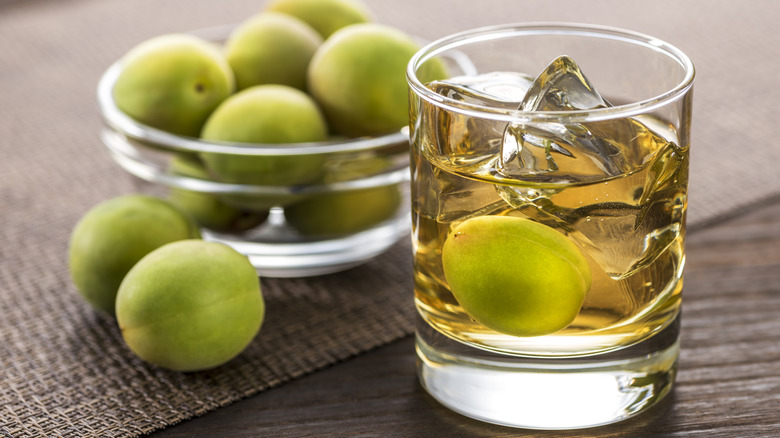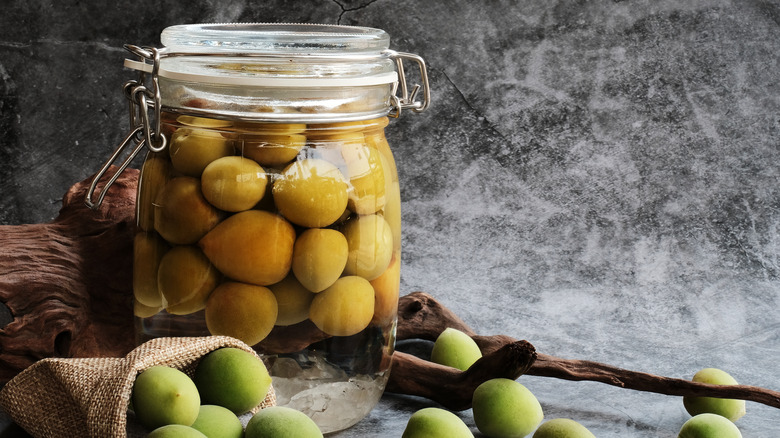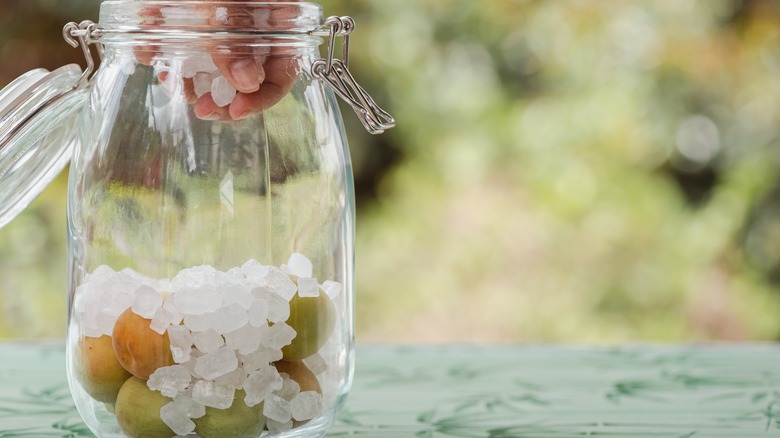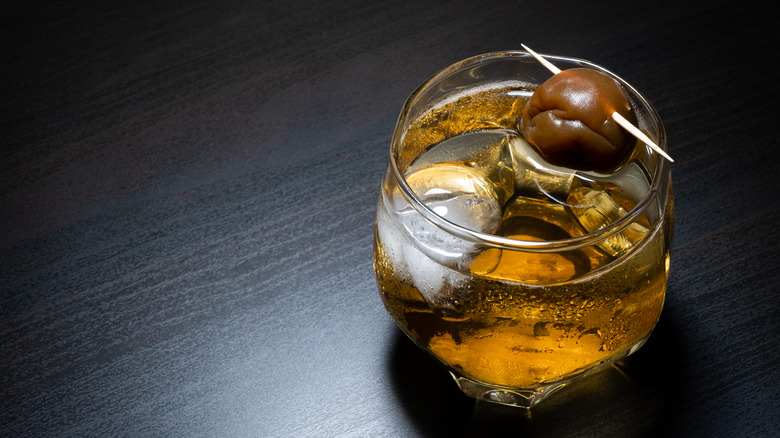Umeshu Is Japan's Sweet Plum Liqueur You Should Know About
Most of the fruits we enjoy tend to go from sour to sweet as they ripen, thanks to the biochemical reaction that sees its fructose quantity increase. But that's not the case with the Japanese ume, which continues to taste quite sour as it matures. While that may leave you with an unappetizing piece of fruit with the potential to give you a stomachache, this hasn't stopped the fruit of the plum blossom from becoming popular in its home country. Ume, which sits closer on the fruit scale to an apricot than a plum, is not eaten as is. Instead it is usually pickled, made into jam and vinegar, or mixed with a neutral spirit like shochu — Japan's traditional distilled spirit made with grains, vegetables, and sugar — or sake. When that happens, ume becomes a key ingredient for umeshu, one of the country's most popular alcoholic beverages.
Two types of umeshu can now be found in supermarkets across Japan. The first type, known as "honkaku umeshu" makes use of real fruit (you'll even see the ume sitting at the bottom of the bottle) and is labelled as such. The other, known as "gosei umeshu" uses additives and extracts, making it cheaper. As such, the latter is seen to be of inferior quality.
History of umeshu
While ume fruit is believed to have made the journey to Japan from China more than 1,000 years ago, no records of an alcoholic beverage made with the fruit have been found before the Edo period, which began in the 17th century. Early recipes indicate umeshu was used as a health tonic and a cure-all that could relieve symptoms including sore throats, colds, and aching muscles. But no matter how healthy umeshu might have been, people were not allowed to pick the fruit and make the beverage at home until the early 20th century during the Showa era. By that time, people were allowed to blend their own, since the process of making umeshu involves soaking fruit in a pre-made alcohol and sugar, without distilling any liquor.
Because spirits are added to the fruit, umeshu's ABV depends entirely on what is used to make it; if shochu is used, you can expect a drink with 35% ABV, while some brands of umeshu can have an ABV of just 9%. Umeshu may be primarily enjoyed as an alcoholic beverage today, but fans still swear by its curative properties. A glass of this fruit liquor can help stimulate the appetite and is said to be very good for digestion.
How umeshu is made
Plum season, which happens between May and June, is the time of year for making umeshu. The liquor is created by mixing fresh whole green ume with a spirit of your choice — sake, shochu, or vodka all work, as long as the alcohol is colorless and as neutral as possible. If you're in Japan and want to do this the way the locals do, a special "White Liquor" is distilled specially for those who want to make the drink at home.
To ensure your homemade umeshu is a success, begin by examining your fruits carefully, discarding all that are spoiled or bruised, then removing their stems fully. Some also recommend poking the fruit so it has small holes to allow its juices to come out more easily. Place the plums inside a clean jar, alternating layers with Japanese rock sugar. Repeat until all the plums and sugar are in place, then add the liquor. Seal the jar carefully, and leave in a cool dark place.
If you don't have any rock sugar handy, you can use other types of sugar including granulated and brown sugar, but you may not get the same effect, since the sugar might end up at the bottom of the jar instead of in between the fruit. Umeshu turns a dark amber color when it is ready to be consumed. Generally, that transformation takes place between six months to a year.
How to enjoy umeshu
Once your homemade umeshu is ready or if you've purchased a bottle pre-made, know that there are no rules for drinking this versatile fruit liquor, which tastes both sweet and tangy, thanks to the combination of sugar and sour fruit. It can be enjoyed on ice or warmed up; it's also enjoyable at room temperature. An umeshu cocktail can be given a lift with the addition of sparkling water. And even though it is a fruit liquor, umeshu is not limited in its use as a mixer either. Serve it with shisho leaves (a relative of mint) and lime for a Japanese take on a refreshing mojito, or add it to plain black coffee for a caffeine buzz with a difference.
Umeshu has no expiration date', but if you plan to keep a bottle around for a while, you might need to remove the whole plums inside the bottle, since they are likely to begin degrading in the alcohol, potentially compromising its flavor. The fruit shouldn't be discarded, though, because ume can be cooked into other dishes like pastries or jams.



